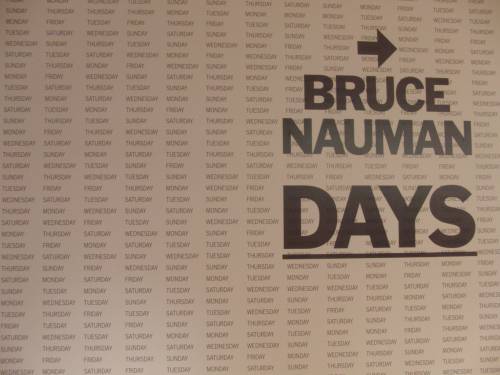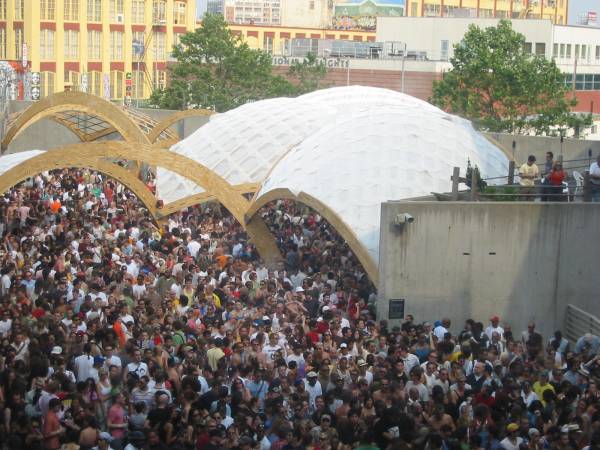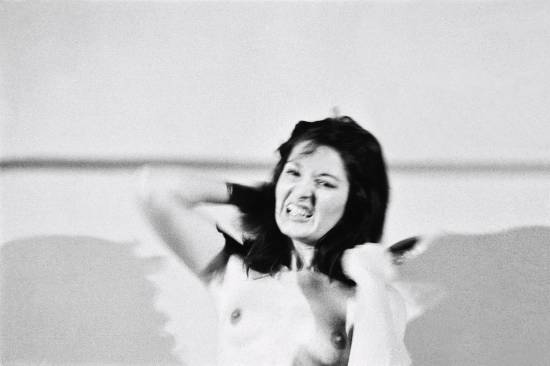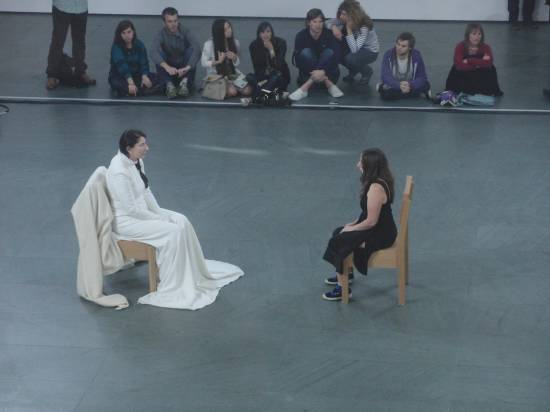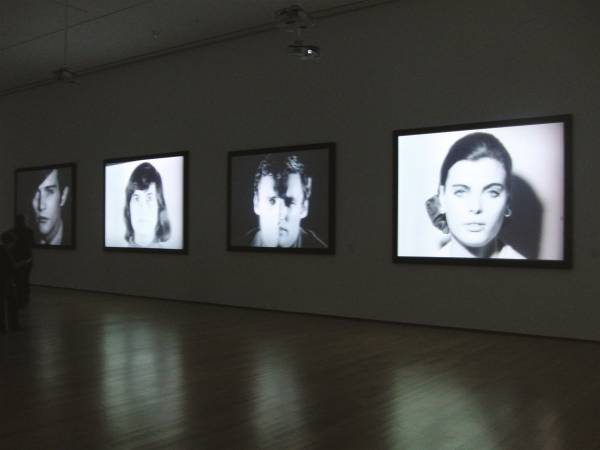
“Andy Warhol: Motion Pictures,” installation shot, 16mm film (black and white, silent), © 2010 The Andy Warhol Museum, Pittsburgh, PA, a museum of Carnegie Institute. All rights reserved (photo by twi-ny/mdr)
Museum of Modern Art
The International Council of the Museum of Modern Art Gallery, sixth floor
11 West 53rd St. between Fifth & Sixth Aves.
Wednesday – Monday through March 21, $20 (includes admittance to same-day film programs)
212-708-9400
www.moma.org
From 1964 to 1966, Andy Warhol attempted to film nearly everyone who entered the Factory, capturing them in four-minute silent black-and-white segments he called “Screen Tests,” with the subjects usually just staring directly into the camera the entire time. MoMA has turned one of its sixth-floor spaces into a moving-portrait gallery, as twelve of the Screen Tests are being shown concurrently, hung on the walls like a series of large-scale paintings, with visitors feeling like they’ve just walked into a (rather introspective) Factory gathering. Shot at twenty-four frames per second but projected at sixteen, the shorts have a beautiful, slow, loving pace to them, but several of them have tragic elements if you are familiar with the person’s ultimate fate. For this rare display, curator Klaus Biesenbach has selected the following Factory celebrities and would-be Superstars: poet-activist Allen Ginsberg; musician Lou Reed; actor and painter Dennis Hopper; Kathe Dees; actress and art collector Baby Jane Holzer (who brushes her teeth); Japanese actress Kyoko Kishida; writer-activist-theorist Susan Sontag; art patron Ethel Scull; actress and socialite Edie Sedgwick, who died of an overdose of prescription medication and alcohol in 1971 at the age of twenty-eight; model-actress Donyale Luna, who died of an overdose in 1979 at the age of thirty-three; actor Paul America, who died in a car accident in 1982 at the age of thirty-eight; actress and Velvet Underground singer Nico, who died from a cerebral hemorrhage in 1988 at the age of forty-nine; and Italian actor and musician Gino Piserchio, who died in 1989 of an AIDS-related infection at the age of forty-four. The Screen Tests are supplemented by several of Warhol’s heavily influential, controversial films, from the same early 1960s period, that deal with humanity’s deepest needs and desires, including BLOW JOB, EAT, SLEEP, and KISS, the latter shown in the seated back screening room. On March 2, the full five-and-a-half-hour SLEEP will be screened in the rear gallery, while the complete eight-hour EMPIRE will be shown on alternate Fridays, February 18 and March 4 and 18. Also, in conjunction with the exhibit, there will be a MoMA Talk on March 3 at 6:00, “Warhol, On Screen, Off Screen,” with writer John Giorno and artist Conrad Ventur, moderated by curator Klaus Biesenbach. And finally, if you visit the above website, you can even make your own Warhol Screen Test.
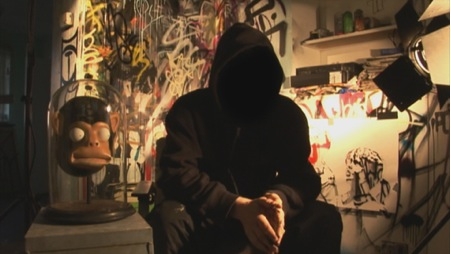
 In 1999, L.A.-based French shopkeeper and amateur videographer Thierry Guetta discovered that he was related to street artist Invader and began filming his cousin putting up his tile works. Guetta, who did not know much about art, soon found himself immersed in the underground graffiti scene. On adventures with such famed street artists as Shepard Fairey, Swoon, Ron English, and Borf, Guetta took thousands of hours of much-sought-after video. The amateur videographer was determined to meet Banksy, the anarchic satirist who has been confounding authorities around the world with his striking, politically sensitive works perpetrated right under their noses, from England to New Orleans to the West Bank. Guetta finally gets his wish and begins filming the seemingly unfilmable as Banksy, whose identity has been a source of controversy for more than a decade, allows Guetta to follow him on the streets and invites him into his studio. But as he states at the beginning of his brilliant documentary, EXIT THROUGH THE GIFT SHOP, Banksy—who hides his face from the camera in new interviews and blurs it in older footage—turns the tables on Guetta, making him the subject of this wildly entertaining film.
In 1999, L.A.-based French shopkeeper and amateur videographer Thierry Guetta discovered that he was related to street artist Invader and began filming his cousin putting up his tile works. Guetta, who did not know much about art, soon found himself immersed in the underground graffiti scene. On adventures with such famed street artists as Shepard Fairey, Swoon, Ron English, and Borf, Guetta took thousands of hours of much-sought-after video. The amateur videographer was determined to meet Banksy, the anarchic satirist who has been confounding authorities around the world with his striking, politically sensitive works perpetrated right under their noses, from England to New Orleans to the West Bank. Guetta finally gets his wish and begins filming the seemingly unfilmable as Banksy, whose identity has been a source of controversy for more than a decade, allows Guetta to follow him on the streets and invites him into his studio. But as he states at the beginning of his brilliant documentary, EXIT THROUGH THE GIFT SHOP, Banksy—who hides his face from the camera in new interviews and blurs it in older footage—turns the tables on Guetta, making him the subject of this wildly entertaining film.
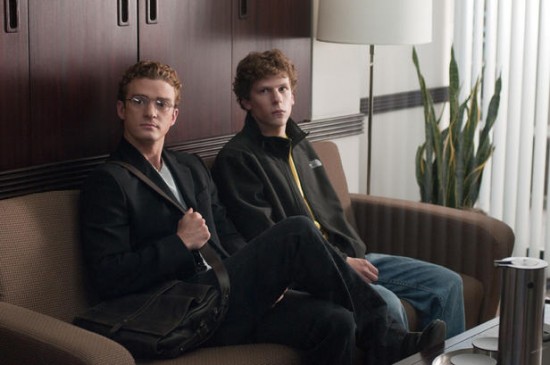
 One of the most widely praised films of 2010, THE SOCIAL NETWORK is being screened at the Museum of Modern Art on Tuesday night as part of the series “The Contenders 2010,” a collection of influential and innovative international movies the institution believes will stand the test of time. MoMA has already shown such works as Luca Guadagnino’s I AM LOVE, Christopher Nolan’s INCEPTION, Roman Polanski’s THE GHOST WRITER, and Mads Brügger’s THE RED CHAPEL, and upcoming films include Yael Hersonski’s A FILM UNFINISHED, Mark Romanek’s NEVER LET ME GO, and Banksy’s EXIT THROUGH THE GIFT SHOP. In THE SOCIAL NETWORK, Jesse Eisenberg stars as computer whiz kid Mark Zuckerberg as he develops what became Facebook while attending Harvard. The film is told primarily in flashback as Zuckerberg is being sued for having allegedly stolen the idea from the Winklevoss twins (both played by Arnie Hammer). Zuckerberg is depicted as a spiteful, mean-spirited, self-indulgent person trying to prove to his ex-girlfriend (Erica Albright) that he will amount to something. Justin Timberlake is outstanding as the fast-moving, smooth-talking Sean Parker, the founder of Napster who loves living the high life. For a young man who created a social media platform where people collect friends, Zuckerberg made a lot of enemies on his way to the top. The film was written by Aaron Sorkin (A FEW GOOD MEN, THE WEST WING), who makes an appearance as an ad executive meeting with Zuckerberg, and directed by David Fincher, who has made such other terrific films as FIGHT CLUB, ZODIAC, and THE CURIOUS CASE OF BENJAMIN BUTTON. Eisenberg (THE SQUID AND THE WHALE, ADVENTURELAND) will participate in a Q&A following the MoMA screening.
One of the most widely praised films of 2010, THE SOCIAL NETWORK is being screened at the Museum of Modern Art on Tuesday night as part of the series “The Contenders 2010,” a collection of influential and innovative international movies the institution believes will stand the test of time. MoMA has already shown such works as Luca Guadagnino’s I AM LOVE, Christopher Nolan’s INCEPTION, Roman Polanski’s THE GHOST WRITER, and Mads Brügger’s THE RED CHAPEL, and upcoming films include Yael Hersonski’s A FILM UNFINISHED, Mark Romanek’s NEVER LET ME GO, and Banksy’s EXIT THROUGH THE GIFT SHOP. In THE SOCIAL NETWORK, Jesse Eisenberg stars as computer whiz kid Mark Zuckerberg as he develops what became Facebook while attending Harvard. The film is told primarily in flashback as Zuckerberg is being sued for having allegedly stolen the idea from the Winklevoss twins (both played by Arnie Hammer). Zuckerberg is depicted as a spiteful, mean-spirited, self-indulgent person trying to prove to his ex-girlfriend (Erica Albright) that he will amount to something. Justin Timberlake is outstanding as the fast-moving, smooth-talking Sean Parker, the founder of Napster who loves living the high life. For a young man who created a social media platform where people collect friends, Zuckerberg made a lot of enemies on his way to the top. The film was written by Aaron Sorkin (A FEW GOOD MEN, THE WEST WING), who makes an appearance as an ad executive meeting with Zuckerberg, and directed by David Fincher, who has made such other terrific films as FIGHT CLUB, ZODIAC, and THE CURIOUS CASE OF BENJAMIN BUTTON. Eisenberg (THE SQUID AND THE WHALE, ADVENTURELAND) will participate in a Q&A following the MoMA screening.
